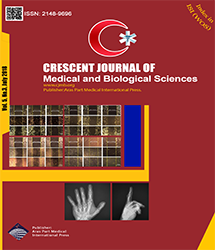| Original Article | |
| The Relationship of Maternal KIR and Parental HLA-C Genes With Risk of Recurrent Spontaneous Abortion: A Regional Study in Lorestan Province, Iran | |
| Soheila Akbari1, Seyyed Amir Yasin Ahmadi2, Farhad Shahsavar3 | |
| 1Department of Obstetrics and Gynecology, Lorestan University of Medical Sciences, Khorramabad, Iran 2Pediatric Growth and Development Research Center, Institute of Endocrinology and Metabolism, Iran University of Medical Sciences, Tehran, Iran 3Department of Immunology, Lorestan University of Medical Sciences, Khorramabad, IranDepartment of Immunology, Lorestan University of Medical Sciences, Khorramabad, Iran |
|
|
CJMB 2018; 5: 194–197 Viewed : 5528 times Downloaded : 3627 times. Keywords : Recurrent spontaneous abortion, KIR, HLA-C |
|
| Full Text(PDF) | Related Articles | |
| Abstract | |
Objectives: Natural killer cells (NKs) are one of the most important cells which play a key role in fetomaternal immune tolerance. This immune tolerance is induced by the interaction of fetal human leucocyte antigens (HLAs) and maternal killer-cell immunoglobulin-like receptors (KIRs). Hence, we intended to investigate the relationship of maternal KIR, parental HLA-C, and maternal-parental KIR+HLA-C with the risk of recurrent spontaneous abortion (RSA). Materials and Methods: The present regional study in Lorestan province of Iran was conducted as a case-control study on 200 couples. Polymerase chain reaction with sequence-specifc primers (PCR-SSP) was used in order to detect genes. Results: A signifcant correlation was found for maternal KIR2DS1 in combination with paternal HLA-C2 (P=0.0089; OR=2.25). Likewise, a signifcant relation was found for maternal C1C2 in combination with paternal C1 or C2 (P=0.0289; OR=2.25). No signifcant relation was found for KIR genes alone. Conclusions: Our study showed a signifcant relation for maternal KIR2DS1 in combination with paternal HLA-C2 as a risk factor in our region. Investigations on this combination for increasing the success rate of assisted reproduction, for frst trimester abortions occurring after implantation and early placentation, for stillbirth groups, and for successful and unsuccessful pregnancies with malformed embryos and fetuses are suggested. |
Online Submission System
 CJMB ENDNOTE ® Style
CJMB ENDNOTE ® Style
 Tutorials
Tutorials
 Publication Charge
Medical and Biological Research Center
About Journal
Publication Charge
Medical and Biological Research Center
About Journal
Aras Part Medical International Press Editor-in-Chief
Arash Khaki
Deputy Editor
Zafer Akan


















